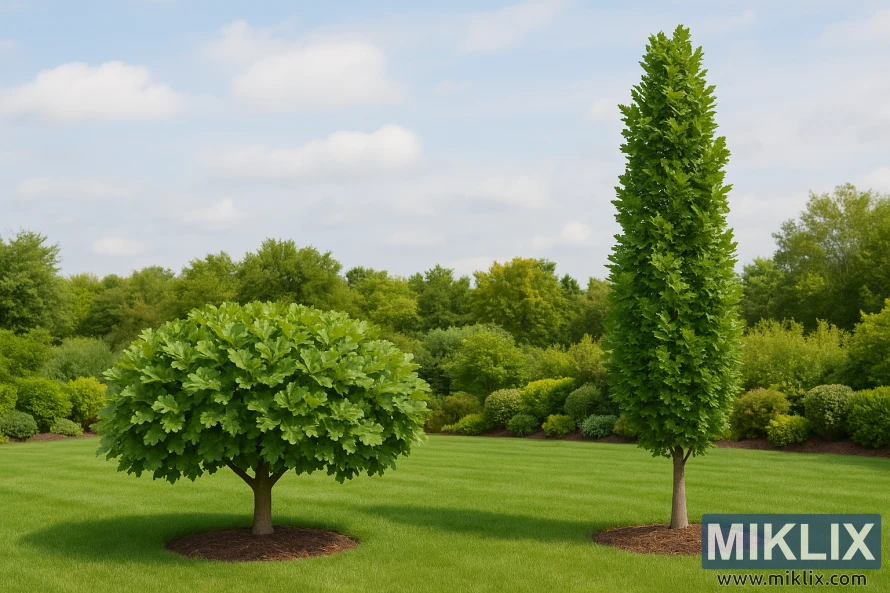Image: Dwarf and Columnar Oaks
Published: August 22, 2025 at 9:05:51 AM UTC
Last updated: September 28, 2025 at 12:18:22 AM UTC
A serene garden scene with a compact dwarf oak and a tall columnar oak, showcasing contrasting forms suited for smaller landscapes.
This visually harmonious landscape image presents a thoughtful study in horticultural contrast and form, showcasing two distinctly shaped oak varieties that are ideally suited for constrained or highly manicured garden settings. The two feature trees stand prominently in the middle ground of an expansive, flawlessly maintained lawn, their forms representing the extremes of horizontal and vertical growth.
On the left, the dwarf oak anchors the horizontal dimension of the scene. This tree possesses a remarkably compact, dense, and rounded canopy, which has been meticulously pruned to achieve an almost perfect, symmetrical sphere. The crown is packed with vibrant, dark green foliage, creating a solid, uniform mass of color and texture that extends close to the ground. The trunk is short and sturdy, allowing the full visual emphasis to be placed on the globular crown, giving the tree a charming, almost bonsai-like majesty. This dwarf form is an excellent example of intentional breeding or careful shaping to provide structure and color without overwhelming a smaller space, making it a perfect architectural feature for a refined garden. Its base is encircled by a neat, dark brown mulch ring, which provides a crisp, defined line separating the natural elements and underscoring the high level of care invested in the landscape.
In powerful contrast, the columnar oak stands on the right, defining the verticality of the scene. This tree rises with a strikingly upright and narrow form, its profile a tall, elegant cylinder or spire that tapers slightly to a pointed top. Its branches are tightly layered and ascend close to the main trunk, creating a dense, vertical wall of bright green foliage. This strong, vertical silhouette is ideal for adding height and drama to a landscape without consuming significant width, making it a preferred choice for streetscapes or narrow garden borders. The leaves are a slightly lighter, fresher green than the dwarf oak's, catching the light and highlighting the tree's tight, orderly structure. Like its counterpart, the columnar oak is meticulously framed by a circular mulch bed, reinforcing the deliberate and structured nature of the planting design.
The lawn that serves as the foundation for this pairing is an immaculate, lush carpet of emerald green. The grass is neatly mowed and exhibits the subtle, striated patterning characteristic of professional upkeep, adding a quiet, repeating texture that visually grounds the scene. The wide expanse of green draws the eye back into the composition and ensures that the two feature trees remain the undisputed focal points, free from clutter. The ground is gently undulating, adding subtle depth to the flat plane of the lawn.
The background of the image is a rich, multi-layered tapestry of mature greenery and well-tended shrubs, creating a secluded and naturalistic backdrop. Immediately behind the feature trees, a border of trimmed, rounded shrubs provides a clean, structural transition to the taller, more varied canopy of the distant woods. This deeper foliage is composed of various shades of green, ranging from dark emerald to lighter olive, providing considerable depth and chromatic richness. This dense, natural border contrasts the foreground’s formality with a sense of expansive, wilder growth beyond, enhancing the tranquil, park-like atmosphere.
Above the scene, the sky is a soft, gentle blue, dotted with scattered, fluffy white clouds. This bright, open sky provides a perfect, natural light source, casting soft, even illumination across the scene and lending the entire composition a sense of calm, sunny equilibrium. The photograph brilliantly demonstrates the value of architectural planting, showing how form, contrast, and meticulous maintenance can create a dynamic and visually balanced garden space, even with trees of highly divergent growth habits.
The image is related to: Best Oak Trees for Gardens: Finding Your Perfect Match

